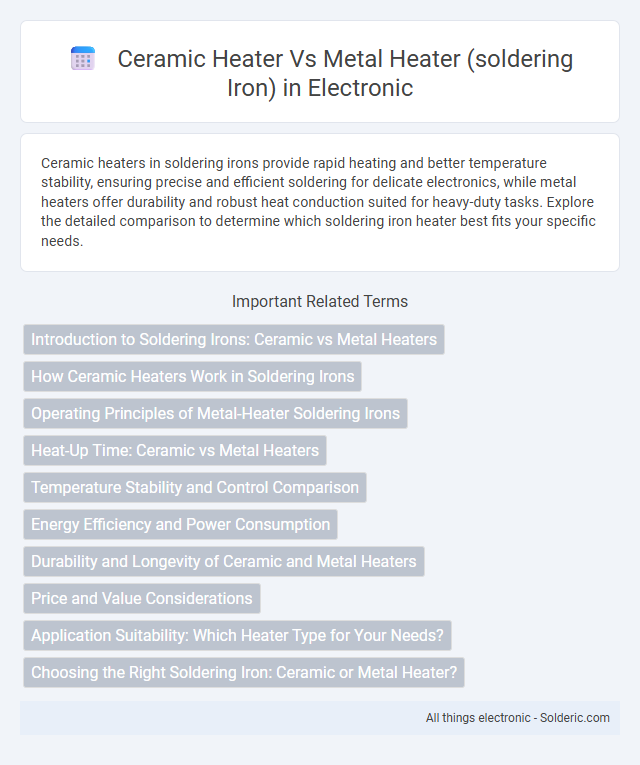Ceramic heaters in soldering irons provide rapid heating and better temperature stability, ensuring precise and efficient soldering for delicate electronics, while metal heaters offer durability and robust heat conduction suited for heavy-duty tasks. Explore the detailed comparison to determine which soldering iron heater best fits your specific needs.
Comparison Table
| Feature | Ceramic Heater | Metal Heater |
|---|---|---|
| Heating Element | Ceramic block | Metal coil or wire |
| Heating Speed | Fast and even heating | Slower, uneven heating |
| Temperature Stability | Highly stable | Less stable |
| Durability | Long-lasting ceramic elements | Prone to oxidation and wear |
| Temperature Range | Up to 450degC or higher | Up to 400degC typically |
| Cost | Generally higher | Lower cost |
| Common Use | Professional soldering irons requiring precision | Basic soldering tasks and hobby use |
| Energy Efficiency | More energy efficient | Less energy efficient |
Introduction to Soldering Irons: Ceramic vs Metal Heaters
Ceramic heaters in soldering irons offer faster heat-up times and more consistent temperature control compared to metal heaters, enhancing precision in electronic soldering. Metal heaters, typically made from nichrome or similar alloys, provide durability and are commonly used in conventional soldering irons but may lack the rapid responsiveness of ceramic elements. Choosing between ceramic and metal heaters depends on the required thermal stability and the complexity of the soldering task.
How Ceramic Heaters Work in Soldering Irons
Ceramic heaters in soldering irons use a ceramic element to generate heat quickly and maintain a stable temperature, ensuring precise control during soldering tasks. This technology provides faster heat-up times and consistent thermal performance compared to traditional metal heaters, which rely on resistive metal coils that heat more slowly and unevenly. Your soldering experience benefits from improved energy efficiency and reduced tip oxidation, enhancing the quality and reliability of electronic connections.
Operating Principles of Metal-Heater Soldering Irons
Metal-heater soldering irons operate by using a resistive metal heating element that converts electrical energy directly into heat through Joule heating. This heating element is typically a metal wire coil or strip that rapidly reaches high temperatures when current passes through it, allowing precise temperature control for soldering tasks. Understanding this principle can help you choose a soldering iron that provides consistent heat for efficient and reliable electronic work.
Heat-Up Time: Ceramic vs Metal Heaters
Ceramic heaters in soldering irons typically offer faster heat-up times, reaching target temperatures within 10 to 30 seconds due to their efficient thermal conductivity and lower mass. Metal heaters, while durable, generally require longer to heat up, often taking 30 to 60 seconds or more because of higher thermal inertia. The rapid heat-up capability of ceramic heaters enhances productivity and precision in electronics soldering tasks.
Temperature Stability and Control Comparison
Ceramic heaters in soldering irons provide superior temperature stability due to their rapid heating and precise control, maintaining consistent heat levels crucial for delicate electronics work. Metal heaters, while durable, often have slower temperature recovery times and less accurate regulation, leading to fluctuations that can affect soldering quality. Your choice of heater impacts the consistency and reliability of your soldering performance, with ceramic options typically offering better temperature control for sensitive tasks.
Energy Efficiency and Power Consumption
Ceramic heaters in soldering irons typically offer higher energy efficiency due to their rapid heating capabilities and superior heat retention, resulting in reduced power consumption during use. Metal heaters, such as traditional nichrome wire elements, generally consume more power as they take longer to reach operating temperature and lose heat faster. Optimizing soldering performance with ceramic heaters can lead to lower electricity costs and more consistent thermal output for precision tasks.
Durability and Longevity of Ceramic and Metal Heaters
Ceramic heaters in soldering irons offer superior durability due to their resistance to oxidation and thermal shock, ensuring a consistent heating element over extended use. Metal heaters, while often providing faster heat-up times, tend to degrade quicker as repeated heating and cooling cycles cause oxidation and element wear. Your choice of heater impacts longevity, with ceramic options generally delivering longer service life and more stable performance in high-demand soldering tasks.
Price and Value Considerations
Ceramic soldering iron heaters typically cost more upfront but offer longer lifespan and consistent heat distribution, providing better value for frequent use. Metal heaters are generally cheaper initially but may require more frequent replacements due to uneven heating and faster wear. Your choice depends on balancing budget constraints with long-term efficiency and durability needs.
Application Suitability: Which Heater Type for Your Needs?
Ceramic heaters in soldering irons offer rapid heat-up times and stable temperature control, making them ideal for delicate electronics and precision work. Metal heaters provide robust and uniform heat distribution, suitable for heavy-duty soldering tasks on larger components or metal surfaces. Your choice depends on the specific application requirements, with ceramic heaters favored for fine, detailed projects and metal heaters preferred for durability and high-power soldering.
Choosing the Right Soldering Iron: Ceramic or Metal Heater?
Ceramic heaters in soldering irons provide rapid, even heating and precise temperature control, making them ideal for delicate electronic components and fine soldering tasks. Metal heaters offer durability and consistent heat retention, better suited for heavy-duty or extended soldering operations where sustained temperature is critical. Prioritize ceramic heaters for precision and fast thermal response, while metal heaters excel in robust applications requiring stable, long-term heat delivery.
ceramic heater vs metal heater (soldering iron) Infographic

 solderic.com
solderic.com